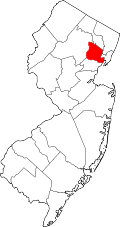Seventh Avenue, Newark
Seventh Avenue, formerly known as the First Ward, is an unincorporated community and neighborhood within the city of Newark in Essex County, New Jersey, United States. It is part of the North Ward, and was famously the heart of the city's large Little Italy.
In its heyday, Seventh Avenue had a population of 30,000, including 11,000 children, in an area of less than a square mile. The center of life in the neighborhood was St. Lucy's Church, founded by Italian immigrants in 1891.[1] Throughout the year, St. Lucy's and other churches sponsored processions in honor of saints that became community events. The most famous procession was the Feast of St. Gerard,[2] but there were also great feasts for Our Lady of Mt. Carmel, Our Lady of Snow, the Assumption, and St. Rocco.
Joe DiMaggio loved the restaurants of Seventh Avenue so much that he would take the New York Yankees to Newark to show them "real Italian food." Frank Sinatra had bread from Giordano's Bakery sent to him every week until his death, no matter where in the world he was.[3] New York Yankees catcher Rick Cerone also grew up in the First Ward.

One of the nation's largest Italian newspapers, The Italian Tribune, was founded on Seventh Avenue. Seventh Avenue produced stars such as Joe Pesci and Frankie Valli of the Four Seasons. Congressman Peter Rodino, Chairman of the House Judiciary Committee during its impeachment proceedings against Richard Nixon was a native of the First Ward as well.
Seventh Avenue was notoriously devastated by urban renewal efforts during the 1950s. Eighth Avenue was obliterated by the city council, scattering the Italian American residents. Most of its businesses never recovered.[4] The construction of Interstate 280 also served to cut the neighborhood off from the rest of the city.
After the devastating urban renewal, some of the First Ward's Italians stayed in the neighborhood, while others migrated to other Newark neighborhoods like Broadway, Roseville, and the Ironbound.
Seventh Avenue has people of all ethnic groups, with Puerto Ricans being prominent. There is still a large Italian American population, and there are many signs of the Italian presence in the area; however, next to a vacant lot, Giordano's at 33 Seventh Avenue is now closed. Drugs and prostitution are a big problem in the area. St Lucy's Church, which is now in a beautiful 1925 building, still exists and has a large feast for St. Gerard every October. The Feast of St. Gerard is a kind of reunion for old First Warders.
By their proximity to I-280, the Christopher Columbus Homes became a highly visible advertisement of Newark's poverty. As residents dwindled away, the Newark Housing Authority took to painting curtains and plants in apartment windows to create the illusion of habitation. Demolition of the projects began in 1994 and is now complete. Townhouses have been built on the former site of the projects, but the old street grid was not restored.
The Seventh Avenue neighborhood lies between the Orange Street and Broad Street stations on the Newark Light Rail. The Seventh Avenue neighborhood is bound by Interstate 280 to the south, Clifton Avenue to the west, Bloomfield Avenue to the north, and Broadway and Broad Street to the east. The Pavilion and Colonnade Apartments are located in the neighborhood.
References
- ↑ Immerso, Michael (2004). Newark's Little Italy: The Vanished First Ward, p. 65. Rutgers University Press.
- ↑ Immerso (2004), p. 83.
- ↑ Lee, Sandra S. (2008). Italian Americans of Newark, Belleville, and Nutley, p. 10. Arcadia Publishing.
- ↑ Immerso (2004), pp. 140–41.
| ||||||||||||||||||||||
| |||||||||||||||||||||||||
| ||||||||||||||
Coordinates: 40°45′07″N 74°10′23″W / 40.75194°N 74.17306°W
